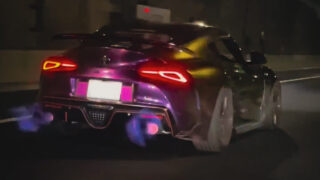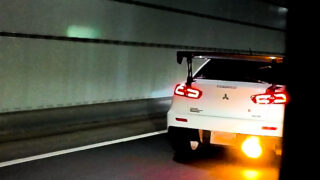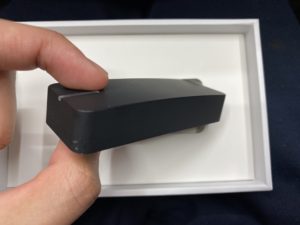学生なら物理で車を考える②【コーナリング編】
首都高と峠でを速く走るにはコーナーをいかに攻められるかということ。私がどのようにしてコーナーを速く曲がる練習をしたかお教えします。
遠心力
まずコーナーを攻めるのはドライ路面だけにしましょう。ウェットは限界が読めない面もあるのでふとした瞬間スーッと流されます。
力は質量×加速度です。遠心力も”質量”と曲がっている方向とは逆向きの”加速度”の積で働きます。
そしてその加速度はカーブの半径と速度に依存します。高速道路で「R=300」とか書いてある標識見たことありませんか?あれは「このカーブは半径300mの円と同じ曲がり具合ですよ」という意味です。カーブの半径をr[m]、速度をv[m/s]とすると加速度aは次の通りです。
$$a=\frac{v^2}{r} [m/s^2]$$遠心力は「速度の二乗に比例」「半径に反比例」します。
例えばあるコーナーをいつも50km/hで曲がっている時、横Gが0.2Gだとしたら、速度が2倍の100km/hで曲がったら横Gは4倍の0.8Gになります。
また半径100mのカーブをある一定の速度で曲がった時の横Gが0.6Gだとした時、半径200mのカーブを同じ速度で曲がると横Gは0.3Gになります。
Gの定義
「Gを感じる〜」とかカーロケに表示されるG、ドラレコの衝撃時録画の衝撃度合いの設定で登場するGなど色々なGがあります。物理学で正確に表される数値としては「〇〇×9.8」を計算した値になり、Gまたはgはある決まった定数であります。
重力にも地面の向きに1Gの加速度が働いており、重力加速度と言います。この重力加速度がGの基準であり、例えばコーナリングで横Gが1.00発生した時は、重力と同じ分の遠心力が発生したことになるわけです。運転していて真横に重力と同じ分の力が発生したらびっくりしますよね。横に1.0Gを発生させるようなコーナリングはそれくらいおっかないということです。
Gを知って練習する
履いているタイヤや車の種類によって限界Gは左右します。私は下の写真のようなGセンサー付きカーロケを車につけております。

こういう加速度センサーを持っていないとイメージが湧かないと思うので例を挙げると、
- 普通のブレーキ:0.1Gから0.2G
- 下手なブレーキ、強いブレーキ:0.3Gから0.5G
- 急ブレーキ、フルブレーキ:0.6Gから1.0Gまたはそれ以上
- 緩やかなカーブ:0.1Gから0.3G
- ちょっと急カーブ、急ハンドル:0.4Gから0.5G
- 首都高、峠で攻める:0.6G以上
- タイヤが鳴り出す:0.8G以上
- アイスバーンでのフルブレーキ:0.1G
- 雪上でのフルブレーキ:〜0.3G
- ウェット路面でのフルブレーキ:0.6Gから0.7G
- ドライ路面でのフルブレーキ:0.7G後半
私は実際に加速度センサーを見ながら走ってみたり、速い車の後をついていって加速度メーターを見ながら曲がったりしながら練習してきました。
いつも使う道のカーブの半径は当然変わりませんよね。自分が何キロで走るかによって遠心力は左右することを頭に入れてきました。いつも100km/hで曲がっているところが0.5Gだから、110km/hなら0.6Gくらいだなって思いながらどんどん限界に近づけていきました。
コーナリングの練習はスピードが出やすい高速道路の方が楽なんですよね。峠とか急なカーブだと、50km/hが70km/hになっただけで横Gは1.4×1.4で1.96倍の約2倍になるのに対し、高速道路で100km/hが120km/hになっても横Gは1.44倍にしかなりません。同じ2倍になるのは200km/hで曲がった時だけ。
峠を限界で曲がっていてちょっとでも限界オーバーな速度で走るとすぐグリップを失いますから危険なのに対し、高速道路なら音を鳴らそうとまでは思わないし、10km/hスピードがアップしただけでもそんなに遠心力は強くなりません。タイヤがなる前にビビってそれ以上出せなくなるだけです。マージンもあるから大丈夫です!
- スープラA90 2022 バブリング ECU特殊ベンチアンロック施工!

- ポルシェ 991.2 ターボ ECUチューニング+バブリング 数時間で100馬力アップ!

- ランエボX バブリング仕様 ECUチューニング 施工させて頂きました!

- マセラティ グランツーリスモ MCストラダーレ ECUチューニング+バブリング施工

- レクサス LC500 ECUチューニング 馬力アップ バブリング リミッター解除 フル仕様!

- フェラーリ458イタリア 即日施工!バブリング(中)およびレブリミッター解除!

- 「本気のアフターファイヤ」アヴェンタドールS LP740 ECU書き換えしました

- レンジローバー スポーツSVR 馬力・トルクアップECUチューニング アイドリングストップ無効化

- 出張施工(鹿児島)にてLP700 バブリング&アフターファイヤ

- 日本初レクサスLC500 バブリング施工 提供開始しました!

- 21クラウンハイブリッド ECUバブリング施工

- 07スーパーグレートをパワーアップ!トラックをECUチューニングしました!

- フェラーリ458スパイダー バブリング&アフターファイヤ施工!爆発レベル最大です!

- バブリング ECU開発成功!レクサスIS500 2URのECUチューニングも可能に!

- マツダ 新型CX-5 スカイアクティブG ECUチューニング!10馬力アップ

- トラックECUチューニング可能!三菱ふそうファイター 馬力アップとEGRカットしました

- ポルシェ 992 カレラT ECUチューニング 馬力アップ!

- ベンツ Sクラス W222 S300h ディーゼル ECUチューニングで即日 馬力・トルクアップ!

- パワー改善!軽トラ ハイゼット ECUチューニングで馬力・トルクアップします!

- フェラーリF430 バブリング仕様にECU書き換え 開発成功!

- フェラーリF8 フルストレート バブリング OPFカット施工 ECU書き換え


